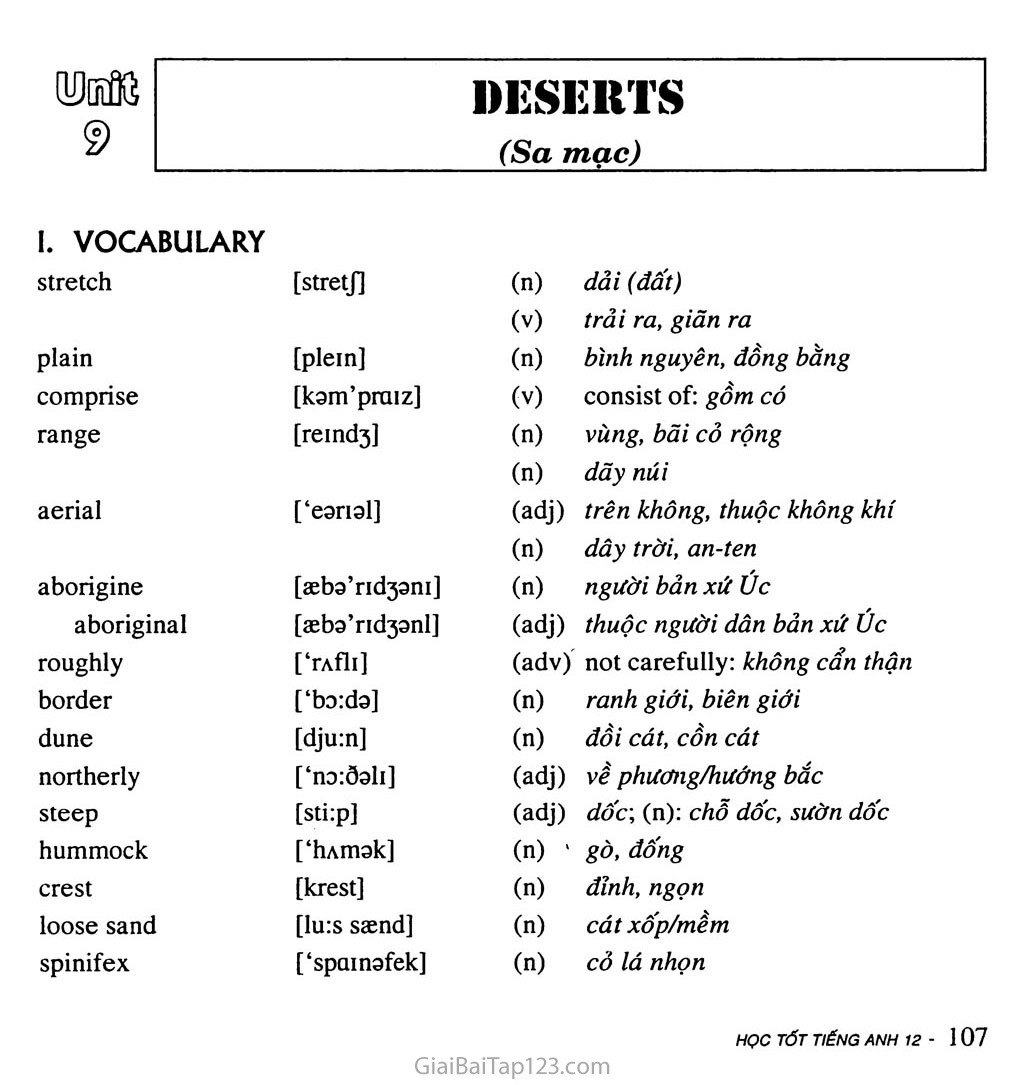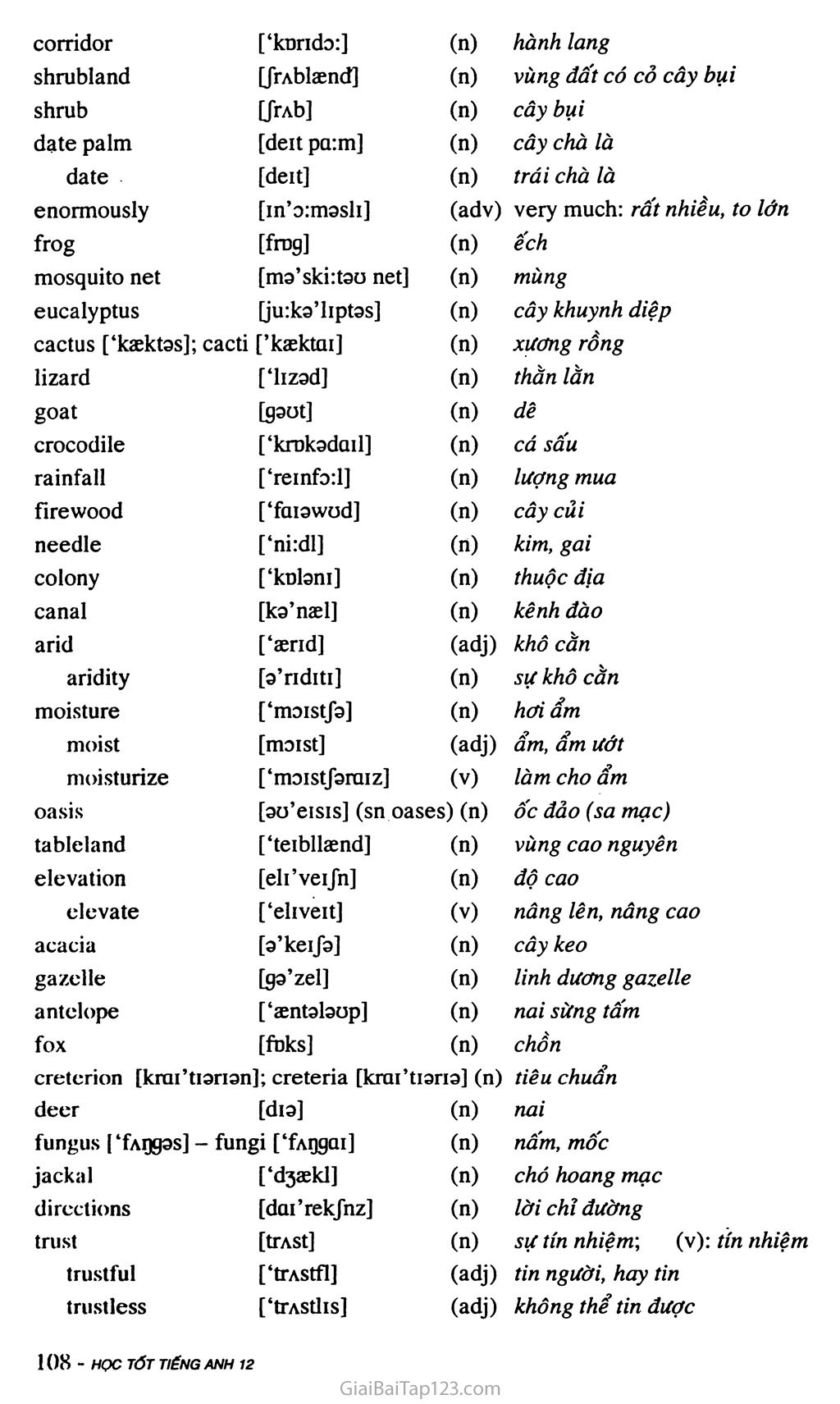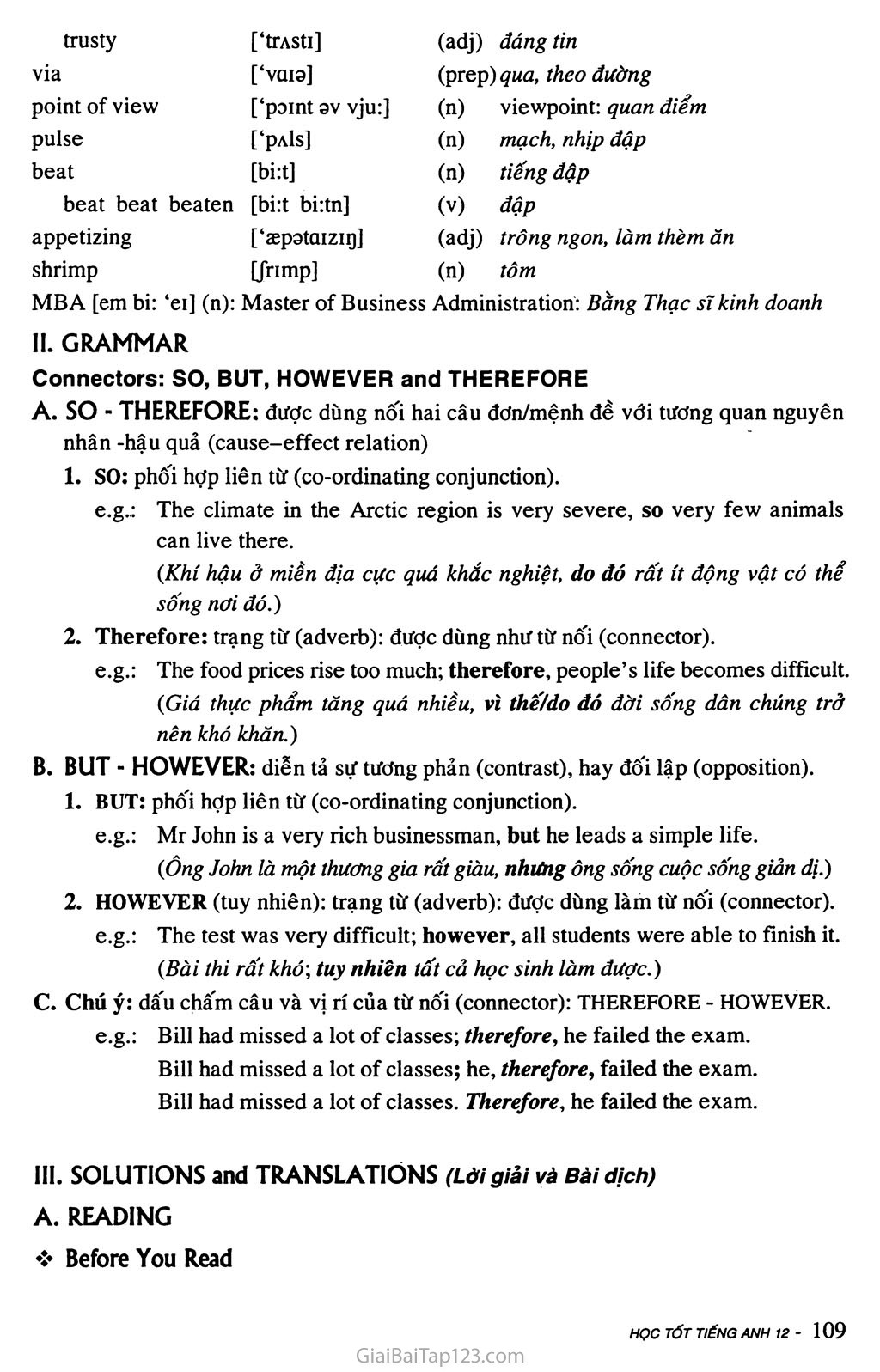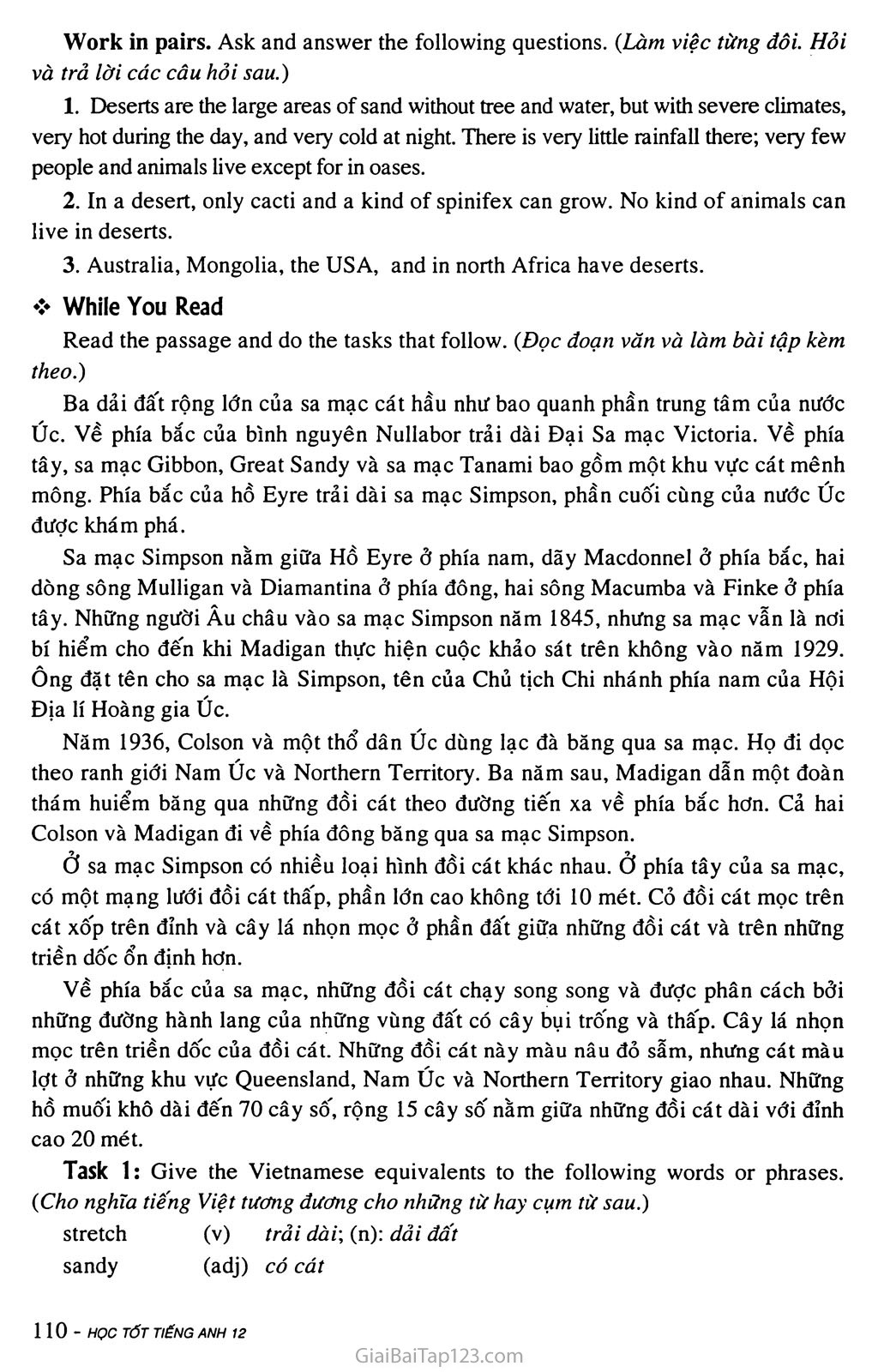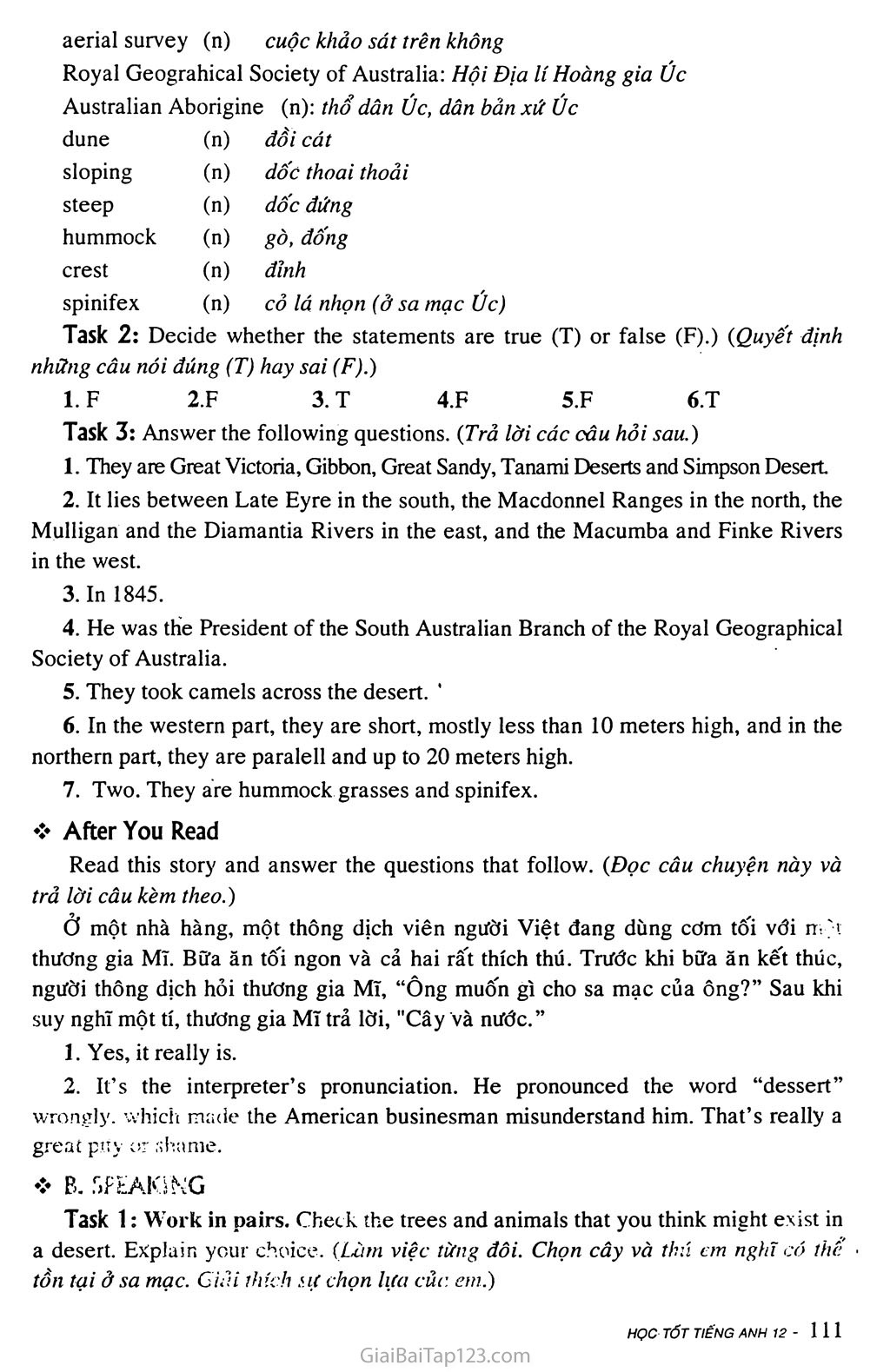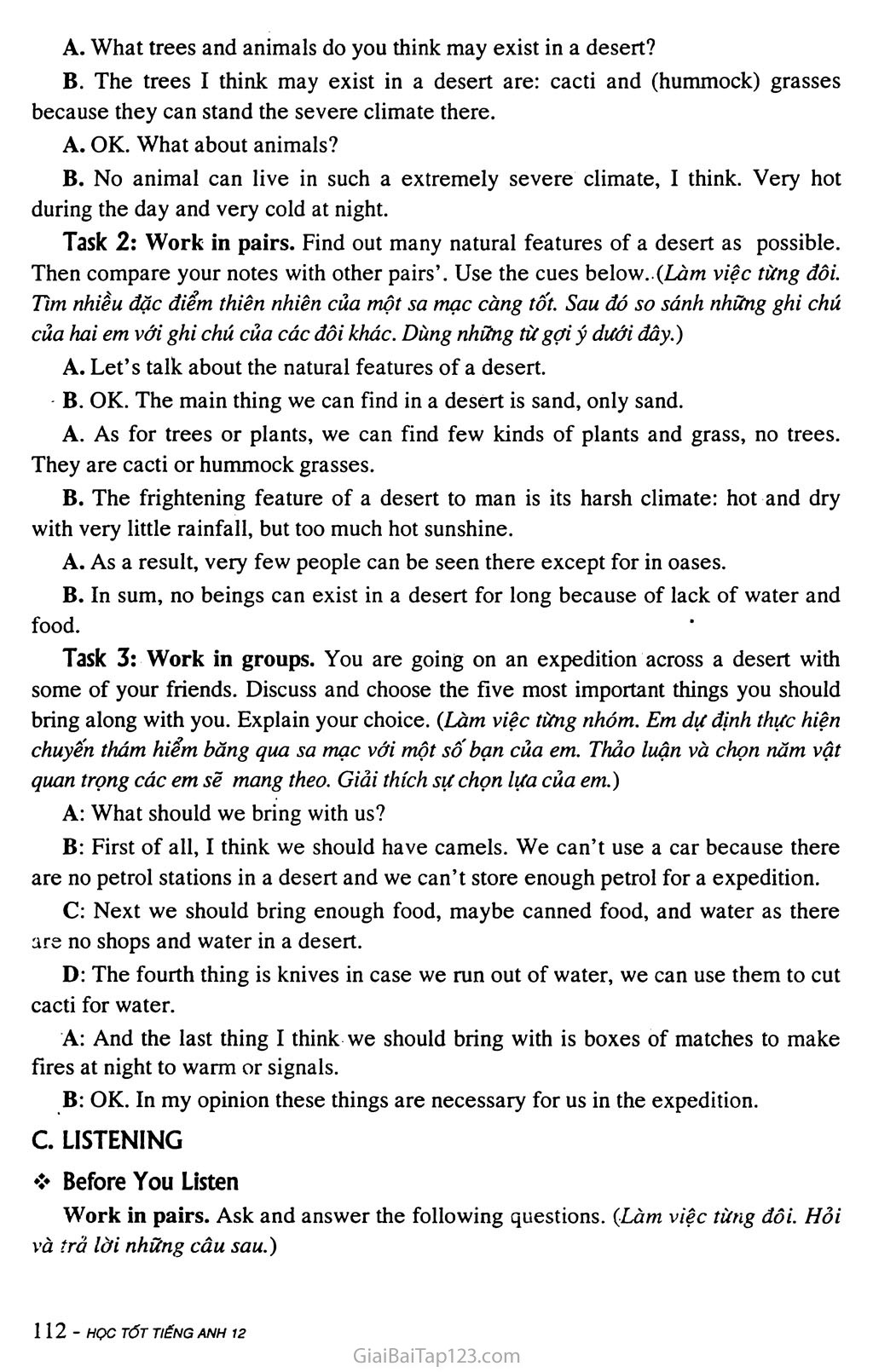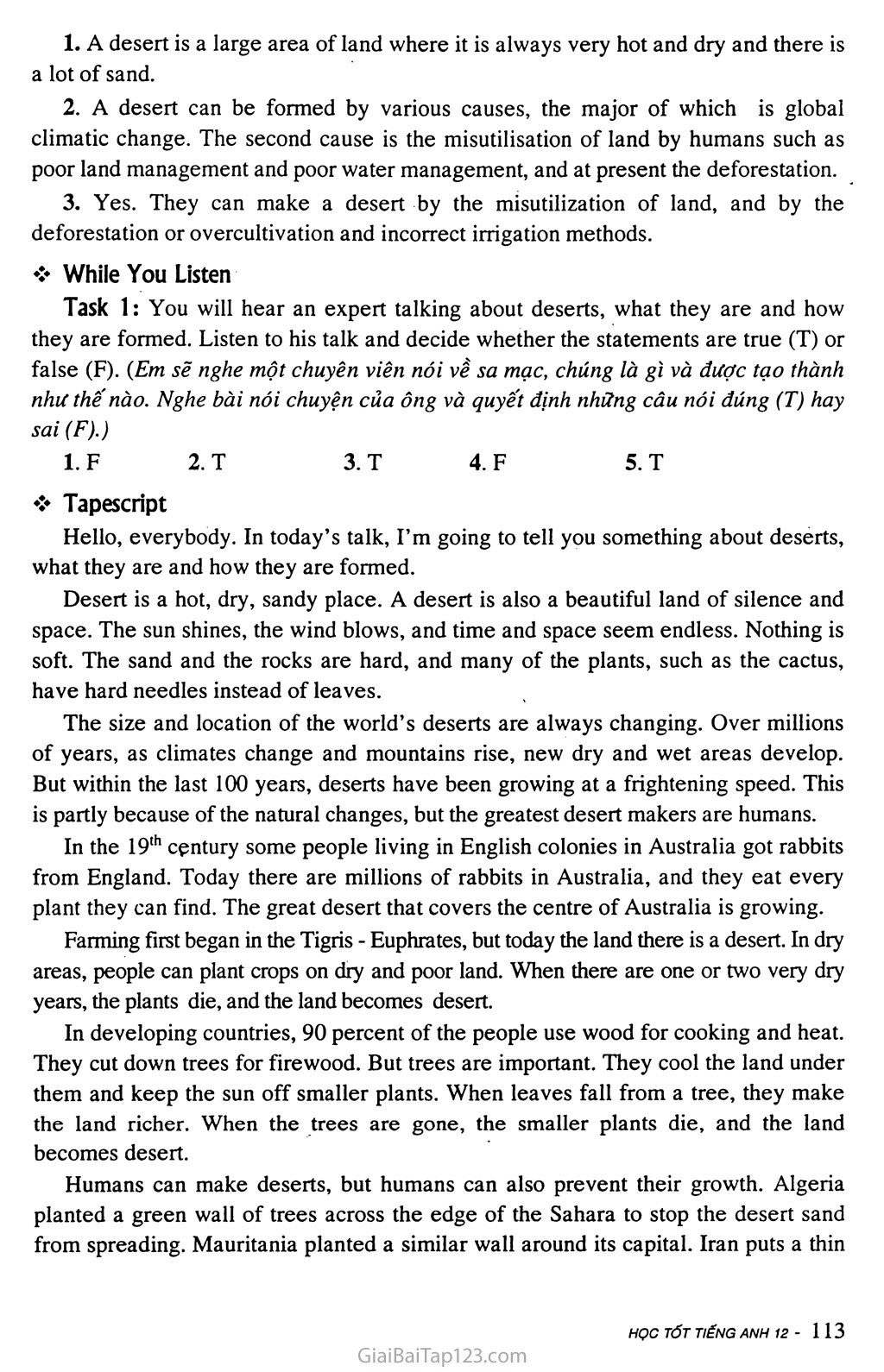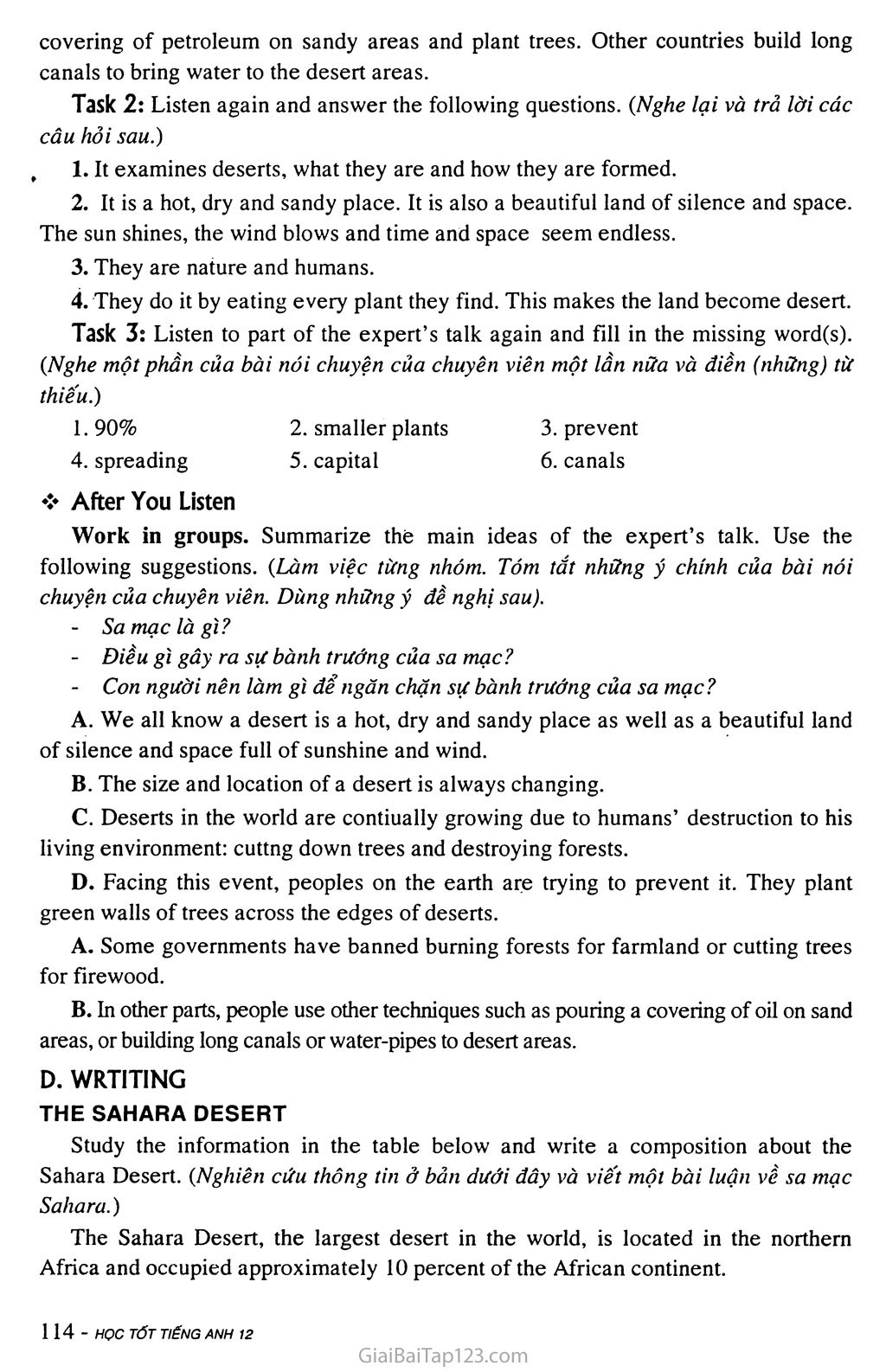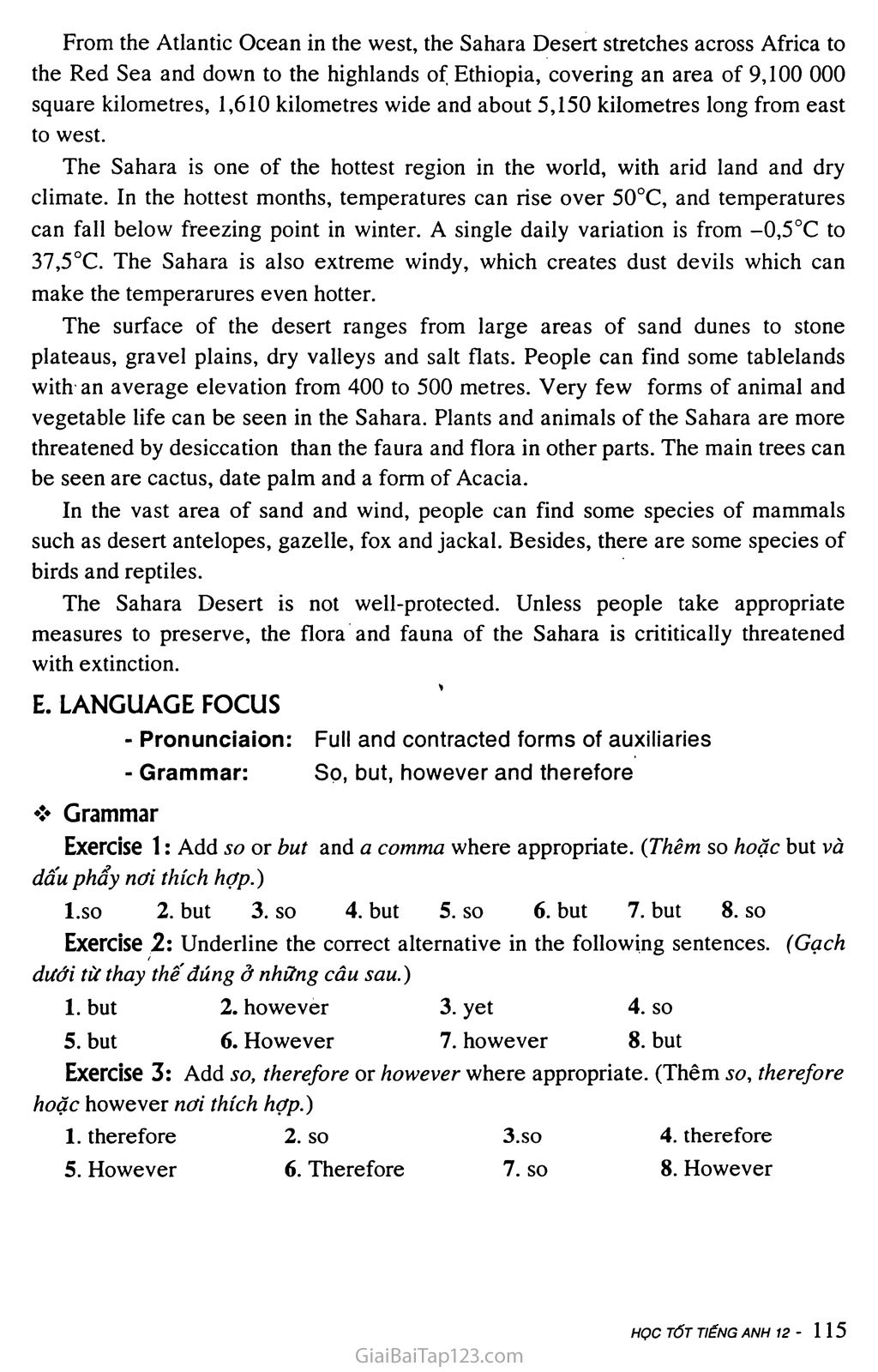Giải tiếng Anh lớp 12 Unit 9: DESERTS
DESERTS
(Sa mạc)
I. VOCABULARY
stretch
[stretfl
(n)
(V)
dải (đất) trải ra, giãn ra
plain
[plein]
(n)
bình nguyên, đồng bằng
comprise
[kom’praiz]
(V)
consist of: gồm có
range
[reind3l
(n)
(n)
vùng, bãi cỏ rộng dãy núi
aerial
[‘earml]
(adj)
(n)
trên không, thuộc không khí dây trời, an-ten
aborigine
[aeba’ridjam]
(n)
người bản xứ Úc
aboriginal
[aeba’ridjanl]
(adj)
thuộc người dân bản xứ úc
roughly
[‘rAfli]
(adv) not carefully: không cẩn thận
border
i‘bo:d3]
(n)
ranh giới, biên giới
dune
[dju:n]
(n)
đồi cát, cồn cát
northerly
[‘no:03li]
(adj)
về phương/hướng bắc
steep
[sti:p]
(adj)
dốc\ (n): chỗ dốc, sườn dốc
hummock
[‘hAmak]
(n) '
gò, đống
crest
[krest]
(n)
đỉnh, ngọn
loose sand
[lu:s saend]
(n)
cát xốp/mềm
spinifex
[‘spainafek]
(n)
cỏ lá nhọn
corridor
[‘kDrida:]
(n)
hành lang
shrubland
IjrAblaend]
(n)
vùng đất có cỏ cây bụi
shrub
LfrAb]
(n)
cây bụi
date palm
[deit pa:m]
(n)
cây chà là
date
[deit]
(n)
trái chà là
enormously
[in’a:masli]
(adv) very much: rất nhiều, to lớn
frog
[frog]
(n)
ếch
mosquito net
[ma’ski:tao net]
(n)
mùng
eucalyptus
[ju:ka’liptas]
(n)
cây khuynh diệp
cactus [‘kaektas]; cacti [’kaektQi]
(n)
xương rồng
lizard
[‘lizad]
(n)
thằn lằn
goat
[gaot]
(n)
dê
crocodile
[‘krokadail]
(n)
cá sấu
rainfall
[‘reinfod]
(n)
lượng mua
firewood
[‘faiawod]
(n)
cây củi
needle
[*ni:dl]
(n)
kim, gai
colony
[‘knlani]
(n)
thuộc địa
canal
[ka’nael]
(n)
kênh đào
arid
[‘aerid]
(adj)
khô cằn
aridity
[a’riditi]
(n)
sự khô cằn
moisture
[‘maistja]
(n)
hơi ẩm
moist
[moist]
(adj)
ẩm, ẩm ướt
moisturize
[‘maistfaraiz]
(V)
làm cho ẩm
oasis
[ao’eisis] (sn oases) (n)
ốc đảo (sa mạc)
tableland
[‘teibllasnd]
(n)
vùng cao nguyên
elevation
[eli’veijn]
(n)
độ cao
elevate
[‘eliveit]
(V)
nâng lên, nâng cao
acacia
[a’keija]
(n)
cây keo
gazelle
[ga’zel]
(n)
linh dương gazelle
antelope
[‘sentalaop]
(n)
nai sừng tấm
fox
[fDks]
(n)
chồn
creterion [krai’tiarian]; creteria [krai’tiaria] (n) tiêu chuẩn
deer
[dia]
(n) nai
fungus I ‘fAggas] -
fungi [‘fAggai]
(n) nấm, mốc
jackal
[‘d3aekl]
(n) chó hoang mạc
directions
[dai’rekjnz]
(n) lời chỉ đường
trust
[trASt]
(n) sự tín nhiệm\ (v): tín nhiệm
trustful
[‘tTAStfl]
(adj) tin người, hay tin
trustless
[‘tTAStlis]
(adj) không thể tin được
trusty
[‘tTAStl]
(adj)
đáng tin
via
[‘vaio]
(prep) qua, theo đường
point of view
[‘point 3V vju:]
(n)
viewpoint: quan điểm
pulse
[‘pxls]
(n)
mạch, nhịp đập
beat
[bi:t]
(n)
tiếng đập
beat beat beaten
[bi:t bi:tn]
(V)
đập
appetizing
[‘aepotaizir)]
(adj)
trông ngon, làm thèm ăn
shrimp
Lfnmp]
(n)
tôm
MBA [em bi: ‘ei] (n): Master of Business Administration: Bằng Thạc sĩ kinh doanh
GRAMMAR
Connectors: so, BUT, HOWEVER and THEREFORE
SO - THEREFORE: được dùng nối hai câu đơn/mệnh đề với tương quan nguyên nhân -hậu quả (cause-effect relation)
SO: phôi hợp liên từ (co-ordinating conjunction).
e.g.: The climate in the Arctic region is very severe, so very few animals can live there.
(Khí hậu ở miền địa cực quá khắc nghiệt, do đó rất ít động vật có thể sống nơi đó.)
Therefore: trạng từ (adverb): được dùng như từ nối (connector).
e.g.: The food prices rise too much; therefore, people’s life becomes difficult. (Giá thực phẩm tăng quá nhiều, vì thế/do đó đời sống dân chúng trở nên khó khăn.)
BUT • HOWEVER: diễn tả sự tương phản (contrast), hay đối lập (opposition).
BUT: phối hợp liên từ (co-ordinating conjunction).
e.g.: Mr John is a very rich businessman, but he leads a simple life.
(Ông John là một thương gia rất giàu, nhưng ông sống cuộc sống giản dị.)
HOWEVER (tuy nhiên): trạng từ (adverb): được dùng làm từ nối (connector), e.g.: The test was very difficult; however, all students were able to finish it.
(Bài thi rất khó', tuy nhiên tất cả học sinh làm được.) c. Chú ý: dấu châm câu và vị rí của từ nốì (connector): THEREFORE - HOWEVER.
e.g.: Bill had missed a lot of classes; therefore, he failed the exam.
Bill had missed a lot of classes; he, therefore, failed the exam.
Bill had missed a lot of classes. Therefore, he failed the exam.
SOLUTIONS and TRANSLATIONS (Lời giải và Bài dịch)
A. READING
❖ Before You Read
Work in pairs. Ask and answer the following questions. {Làm việc từng đôi. Hỏi và trả lời các câu hỏi sau.)
Deserts are the large areas of sand without tree and water, but with severe climates, very hot during the day, and very cold at night. There is very little rainfall there; very few people and animals live except for in oases.
In a desert, only cacti and a kind of spinifex can grow. No kind of animals can live in deserts.
Australia, Mongolia, the USA, and in north Africa have deserts.
❖ While You Read
Read the passage and do the tasks that follow. {Đọc đoạn văn và làm bài tập kèm theo.)
Ba dải đất rộng lớn của sa mạc cát hầu như bao quanh phần trung tâm của nước Úc. về phía bắc của bình nguyên Nullabor trải dài Đại Sa mạc Victoria, về phía tây, sa mạc Gibbon, Great Sandy và sa mạc Tanami bao gồm một khu vực cát mênh mông. Phía bắc của hồ Eyre trải dài sa mạc Simpson, phần cuối cùng của nước úc được khám phá.
Sa mạc Simpson nằm giữa Hồ Eyre ở phía nam, dãy Macdonnel ở phía bắc, hai dòng sông Mulligan và Diamantina ở phía đông, hai sông Macumba và Finke ở phía tây. Những người Âu châu vào sa mạc Simpson năm 1845, nhưng sa mạc vẫn là nơi bí hiểm cho đến khi Madigan thực hiện cuộc khảo sát trên không vào năm 1929. Ông đặt tên cho sa mạc là Simpson, tên của Chủ tịch Chi nhánh phía nam của Hội Địa lí Hoàng gia úc.
Năm 1936, Colson và một thổ dân ức dùng lạc đà băng qua sa mạc. Họ đi dọc theo ranh giới Nam úc và Northern Territory. Ba năm sau, Madigan dẫn một đoàn thám huiểm băng qua những đồi cát theo đường tiến xa về phía bắc hơn. cả hai Colson và Madigan đi về phía đông băng qua sa mạc Simpson.
Ở sa mạc Simpson có nhiều loại hình đồi cát khác nhau. Ở phía tây của sa mạc, có một mạng lưới đồi cát thấp, phần lớn cao không tới 10 mét. cỏ đồi cát mọc trên cát xốp trên đỉnh và cây lá nhọn mọc ở phần đất giữa những đồi cát và trên những triền dốc ổn định hơn.
về phía bắc của sa mạc, những đồi cát chạy song song và được phân cách bởi những đường hành lang của những vùng đất có cây bụi trông và tháp. Cây lá nhọn mọc trên triền dốc của đồi cát. Những đồi cát này màu nâu đỏ sẫm, nhưng cát màu lợt ở những khu vực Queensland, Nam úc và Northern Territory giao nhau. Những hồ muôi khô dài đến 70 cây số, rộng 15 cây sô" nằm giữa những đồi cát dài với đỉnh cao 20 mét.
Task 1: Give the Vietnamese equivalents to the following words or phrases. {Cho nghĩa tiếng Việt tương đương cho những từ hay cụm từ sau.)
stretch (v) trải dài', (n): dải đất
sandy (adj) có cát
aerial survey (n) cuộc khảo sát trên không
Royal Geograhical Society of Australia: Hội Địa lí Hoàng gia úc Australian Aborigine (n): thổ dân ức, dân bản xứ úc
dune
(n)
đồi cát
sloping
(n)
dốc thoai thoải
steep
(n)
dốc đứng
hummock
(n)
gò, đống
crest
(n)
đỉnh
spinifex
(n)
cỏ lá nhọn (ở sa mạc úc)
Task 2: Decide whether the statements are true (T) or false (F).) (Quyết định những câu nói đúng (T) hay sai (F).)
F 2.F 3.T 4.F 5.F 6.T
Task 3: Answer the following questions. (Trả lời các câu hỏi sau.)
They are Great Victoria, Gibbon, Great Sandy, Tanami Deserts and Simpson Desert.
It lies between Late Eyre in the south, the Macdonnel Ranges in the north, the Mulligan and the Diamantia Rivers in the east, and the Macumba and Finke Rivers in the west.
In 1845.
He was the President of the South Australian Branch of the Royal Geographical Society of Australia.
They took camels across the desert.
In the western part, they are short, mostly less than 10 meters high, and in the northern part, they are paralell and up to 20 meters high.
Two. They are hummock grasses and spinifex.
After You Read
Read this story and answer the questions that follow. (Đọc câu chuyện này và trả lời câu kèm theo.)
Ở một nhà hàng, một thông dịch viên người Việt đang dùng cơm tôi với n ■'' thương gia Mĩ. Bữa ăn tôi ngon và cả hai rất thích thú. Trước khi bữa ăn kết thúc, người thông dịch hỏi thương gia Mĩ, “Ông muôn gì cho sa mạc của ông?” Sau khi suy nghĩ một tí, thương gia Mĩ trả lời, "Cây và nước.”
Yes, it really is.
It’s the interpreter’s pronunciation. He pronounced the word “dessert” wrongly, which made the American businesman misunderstand him. That’s really a great pity or shame.
B. SPEAKING
Task 1: Work in pairs. Check the trees and animals that you think might exist in a desert. Explain your choice. (Làm việc từng đôi. Chọn cây và thú em nghĩ có thề tồn tại ở sa mạc. Giải thích sự chọn lựa của em.)
What trees and animals do you think may exist in a desert?
The trees I think may exist in a desert are: cacti and (hummock) grasses because they can stand the severe climate there.
OK. What about animals?
No animal can live in such a extremely severe climate, I think. Very hot during the day and very cold at night.
Task 2: Work in pairs. Find out many natural features of a desert as possible. Then compare your notes with other pairs’. Use the cues below..(Làm việc từng đôi. Tìm nhiều đặc điểm thiên nhiên của một sa mạc càng tốt. Sau đó so sánh những ghi chú của hai em với ghi chú của các đôi khác. Dùng những từ gợi ý dưới đây.)
Let’s talk about the natural features of a desert.
OK. The main thing we can find in a desert is sand, only sand.
As for trees or plants, we can find few kinds of plants and grass, no trees. They are cacti or hummock grasses.
The frightening feature of a desert to man is its harsh climate: hot and dry with very little rainfall, but too much hot sunshine.
As a result, very few people can be seen there except for in oases.
In sum, no beings can exist in a desert for long because of lack of water and food.
Task 3: Work in groups. You are going on an expedition across a desert with some of your friends. Discuss and choose the five most important things you should bring along with you. Explain your choice. (Làm việc từng nhóm. Em dự định thực hiện chuyến thám hiểm băng qua sa mạc với một sô' bạn của em. Thảo luận và chọn năm vật quan trọng các em sẽ mang theo. Giải thích sự chọn lựa của em.)
A: What should we bring with US?
B: First of all, I think we should have camels. We can’t use a car because there are no petrol stations in a desert and we can’t store enough petrol for a expedition.
C: Next we should bring enough food, maybe canned food, and water as there are no shops and water in a desert.
D: The fourth thing is knives in case we run out of water, we can use them to cut cacti for water.
A: And the last thing I think we should bring with is boxes of matches to make fires at night to warm or signals.
B: OK. In my opinion these things are necessary for US in the expedition.
c. LISTENING
❖ Before You Listen
Work in pairs. Ask and answer the following questions. (Làm việc từng đôi. Hỏi và trả lời những câu sau.)
A desert is a large area of land where it is always very hot and dry and there is a lot of sand.
A desert can be formed by various causes, the major of which is global climatic change. The second cause is the misutilisation of land by humans such as poor land management and poor water management, and at present the deforestation.
Yes. They can make a desert by the misutilization of land, and by the deforestation or overcultivation and incorrect irrigation methods.
While You Listen
Task 1: You will hear an expert talking about deserts, what they are and how they are formed. Listen to his talk and decide whether the statements are true (T) or false (F). {Em sẽ nghe một chuyên viên nói về sa mạc, chúng là gì và được tạo thành như thê'nào. Nghe bài nói chuyện của ông và quyết định những câu nói đúng (T) hay sai (F).)
1. F 2. T 3. T 4. F 5. T
Tapescript
Hello, everybody. In today’s talk, I’m going to tell you something about deserts, what they are and how they are formed.
Desert is a hot, dry, sandy place. A desert is also a beautiful land of silence and space. The sun shines, the wind blows, and time and space seem endless. Nothing is soft. The sand and the rocks are hard, and many of the plants, such as the cactus, have hard needles instead of leaves.
The size and location of the world’s deserts are always changing. Over millions of years, as climates change and mountains rise, new dry and wet areas develop. But within the last 100 years, deserts have been growing at a frightening speed. This is partly because of the natural changes, but the greatest desert makers are humans.
In the 19th century some people living in English colonies in Australia got rabbits from England. Today there are millions of rabbits in Australia, and they eat every plant they can find. The great desert that covers the centre of Australia is growing.
Farming first began in the Tigris - Euphrates, but today the land there is a desert. In dry areas, people can plant crops on dry and poor land. When there are one or two very dry years, the plants die, and the land becomes desert.
In developing countries, 90 percent of the people use wood for cooking and heat. They cut down trees for firewood. But trees are important. They cool the land under them and keep the sun off smaller plants. When leaves fall from a tree, they make the land richer. When the trees are gone, the smaller plants die, and the land becomes desert.
Humans can make deserts, but humans can also prevent their growth. Algeria planted a green wall of trees across the edge of the Sahara to stop the desert sand from spreading. Mauritania planted a similar wall around its capital. Iran puts a thin
covering of petroleum on sandy areas and plant trees. Other countries build long canals to bring water to the desert areas.
Task 2: Listen again and answer the following questions. (Nghe lại và trả lời các câu hỏi sau.)
It examines deserts, what they are and how they are formed.
It is a hot, dry and sandy place. It is also a beautiful land of silence and space. The sun shines, the wind blows and time and space seem endless.
They are nature and humans.
They do it by eating every plant they find. This makes the land become desert.
Task 3: Listen to part of the expert’s talk again and fill in the missing word(s).
(Nghe một phần của bài nói chuyện của chuyên viên một lần nữa và điền (những) từ thiếu.)
1.90% 2. smaller plants 3. prevent
spreading 5. capital 6. canals
❖ After You Listen
Work in groups. Summarize the main ideas of the expert’s talk. Use the following suggestions. (Làm việc từng nhóm. Tóm tắt những ý chính của bài nói chuyện của chuyên viên. Dùng những ý đề nghị sau).
Sa mạc là gì?
Điều gì gây ra sự bành trướng của sa mạc?
Con người nên làm gì để ngăn chặn sự bành trướng của sa mạc?
We all know a desert is a hot, dry and sandy place as well as a beautiful land of silence and space full of sunshine and wind.
The size and location of a desert is always changing.
c. Deserts in the world are contiually growing due to humans’ destruction to his living environment: cuttng down trees and destroying forests.
D. Facing this event, peoples on the earth are trying to prevent it. They plant green walls of trees across the edges of deserts.
Some governments have banned burning forests for farmland or cutting trees for firewood.
In other parts, people use other techniques such as pouring a covering of oil on sand areas, or building long canals or water-pipes to desert areas.
D. WRTITING
THE SAHARA DESERT
Study the information in the table below and write a composition about the Sahara Desert. (Nghiên cứu thông tin ở bản dưới đây và viết một bài luận về sa mạc Sahara.)
The Sahara Desert, the largest desert in the world, is located in the northern Africa and occupied approximately 10 percent of the African continent.
From the Atlantic Ocean in the west, the Sahara Desert stretches across Africa to the Red Sea and down to the highlands of Ethiopia, covering an area of 9,100 000 square kilometres, 1,610 kilometres wide and about 5,150 kilometres long from east to west.
The Sahara is one of the hottest region in the world, with arid land and dry climate. In the hottest months, temperatures can rise over 50°C, and temperatures can fall below freezing point in winter. A single daily variation is from -0,5°C to 37,5°c. The Sahara is also extreme windy, which creates dust devils which can make the temperarures even hotter.
The surface of the desert ranges from large areas of sand dunes to stone plateaus, gravel plains, dry valleys and salt flats. People can find some tablelands with an average elevation from 400 to 500 metres. Very few forms of animal and vegetable life can be seen in the Sahara. Plants and animals of the Sahara are more threatened by desiccation than the faura and flora in other parts. The main trees can be seen are cactus, date palm and a form of Acacia.
In the vast area of sand and wind, people can find some species of mammals such as desert antelopes, gazelle, fox and jackal. Besides, there are some species of birds and reptiles.
The Sahara Desert is not well-protected. Unless people take appropriate measures to preserve, the flora and fauna of the Sahara is crititically threatened with extinction.
E. LANGUAGE FOCUS
Pronunciaion: Full and contracted forms of auxiliaries
Grammar: So, but, however and therefore
❖ Grammar
Exercise 1: Add so or but and a comma where appropriate. {Them so hoặc but và dấu phẩy nơi thích hợp.)
l.so 2. but 3. so 4. but 5. so 6. but 7. but 8. so
Exercise 2: Underline the correct alternative in the following sentences. (Gạch dưới từ thay thế đúng ở những câu sau.)
1. but 2. however 3. yet 4. so
but 6. However 7. however 8. but
Exercise 3: Add so, therefore or however where appropriate. (Thêm so, therefore hoặc however nơi thích hợp.)
1. therefore 2. so 3.SO 4. therefore
However 6. Therefore 7. so 8. However

